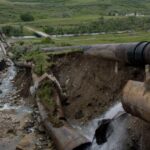HELENA — Attorneys weighed in on the extent of the Montana Constitution’s environmental protections and the separation of powers Wednesday in one of the highest-profile climate lawsuits in the country. During an hour-long hearing that drew hundreds of onlookers, the Montana Supreme Court heard opposing views about whether the Montana Constitution’s “anticipatory and preventative” environmental protections should require state agencies to incorporate climate-oriented analyses when reviewing fossil fuel projects.
Held v. Montana was brought by 16 young Montanans who alleged in their 2020 lawsuit that the state has failed to uphold their constitutional right to a “clean and healthful environment” by failing to scrutinize the climate-warming potential of greenhouse gas-generating projects such as coal-fired power plants and oil pipelines.
In a seven-day trial held in June of last year, the plaintiffs argued that the state has threatened their physical and mental health, economic security, cultural traditions and recreational interests by approving projects that have contributed to longer, more intense wildfire seasons, shrinking snowpacks, dwindling summertime streamflows and extreme weather events.
Credit: Amanda Eggert / MTFP
In August, Lewis and Clark County District Court Judge Kathy Seeley sided with the plaintiffs. In a 103-page ruling, the judge found that Montana contributed to the harm suffered by the youths and has the ability to alleviate those effects by changing its approach to permitting energy projects.
Seeley directed the state to incorporate greenhouse gas analyses in its environmental reviews, a change the Montana Department of Environmental Quality is currently undergoing. Seeley also wrote in the order that the state must either “have discretion to deny permits for fossil fuel activities when the activities would result in [greenhouse gas] emissions that cause unconstitutional degradation and depletion of Montana’s environment and natural resources” or “the permitting statues themselves must be unconstitutional.”
The state’s attorneys emphasized during Wednesday’s hearing that Montana does not deny that climate change is occurring or that it’s accelerated by human activity. Dale Schowengerdt, who represented Gov. Greg Gianforte, the Montana Department of Environmental Quality and two other state agencies in the appeal, instead focused his arguments on whether using the courts to reverse climate change exceeds the “limits of judicial power.”
“This is a complex issue that can’t be solved by, as the Ninth Circuit said, judges. It is, for better or worse, a political question,” he said, referencing an ongoing federal case, Juliana v. United States that has been largely decided in favor of the federal government.
Schowengerdt and Montana Department of Justice Attorney Mark Stermitz also argued the court should adjudicate the questions posed by this case in the context of a specific permitting decision and asserted that plaintiffs’ claims are weakened by the lack of a clear-cut remedy.
Representing the youths, attorney Roger Sullivan countered that deciding the constitutionality of laws like the one at the heart of this lawsuit is precisely the job of the Supreme Court and that the Montana Constitution’s unambiguously protects Montanans right to a functioning “environmental life support system.”
In keeping with the state’s earlier briefs filed in the lawsuit, Stermitz argued that even if the state were to eliminate “every ounce of fossil fuel in use in Montana,” that “will not impact the injuries that the plaintiffs are alleging.”
That, he argued, raises the question of whether the plaintiffs have standing, a legal concept used to determine whether a party has grounds to bring legal claims. Establishing standing typically requires a plaintiff to draw a link between their injuries and the defendant’s actions and to demonstrate that the defendant can alleviate those injuries by altering their actions.
The state’s appeal is supported by the Treasure State Resources Association, the Montana Chamber of Commerce, the Frontier Institute, a free-market think tank, Northwestern Energy and the Montana Legislature, which argued that the district court is usurping the policy-making authority that properly belongs with lawmakers.
Stakeholders that support the district court’s findings include members of Montana’s outdoor recreation industry, a group of public health experts and doctors, a coalition of constitutional and environmental law professors, and a collective of conservation and tribal groups. Six retired Montana Supreme Court justices also weighed in to suggest that the legislative branch has asserted too much control, threatening the separation of powers foundational to the U.S. Constitution.

Credit: Amanda Eggert / MTFP
In his remarks, Sullivan emphasized the urgency of the question before the Supreme Court and argued that it is the appropriate venue for answering such questions given the constitutional harm the plaintiffs recounted in their testimony and the court’s unique role in weighing a law’s constitutionality.
He said the state has failed to protect Montana’s “environmental life support system,” as required by the Montana Constitution, and to the detriment of present and future generations of Montana’s children. In his opening remarks, Sullivan focused on changes to the Montana Environmental Policy Act related to both climate analyses and Montanans’ access to judicial remedies in the face of ill-informed permitting decisions.
“This legislatively imposed doubled-headed hydra closes the eyes of Montana’s environmental agencies to the most serious environmental crisis Montana has ever experienced — the climate crisis — and it closes Montana’s courthouse doors to those seeking redress from the harms hidden from the agency’s eyes,” Sullivan said.
Asked by Justice Jim Rice if the issue is adequately “ripe” for judicial interpretation given that plaintiffs aren’t challenging a specific energy project, Sullivan replied that Montana is in the midst of a climate crisis “right now.”
“The temperature goes up day by day. Maybe the temperature will be hotter tomorrow, but most assuredly, if nothing is done it will be much hotter 50 years from now when those young plaintiffs are my age,” Sullivan said. “This issue could not be more ripe.”
Rice replied that the case is related to another lawsuit that went before the justices in May. That lawsuit involves a gas plant NorthWestern Energy has built in Laurel. That case, which has not yet been decided by the court, also involves the constitutionality of House Bill 971, a law precluding the state from conducting greenhouse gas analyses that legislators passed last year to help NorthWestern’s gas plant overcome a district court ruling that invalidated its permit. That plant is expected to contribute 23 million tons of carbon dioxide to the atmosphere over its 30-year lifetime.
“It’s interesting to contrast this case to the one we [heard] recently about the Laurel power plant … a real case with a real permit. That is lacking here, and it seems like what you’re trying to do here is obtain something like a generic judgment,” he said.
In a post-hearing press conference, Andrea Olson with Our Children’s Trust, the Oregon-based group pursuing youth climate claims against various state and federal authorities, addressed the justice’s contention.
“We are already in an emergency — a piece-by-piece challenge is not the way to go here,” Olson said. “We have to do something that is going to address the root of the problem.”
The justices did not indicate when they would issue a ruling.





